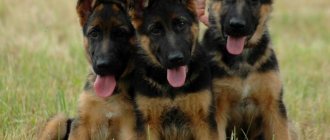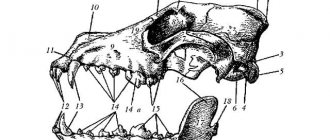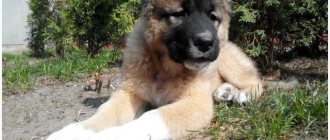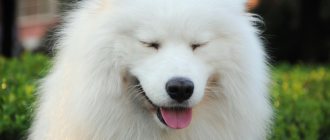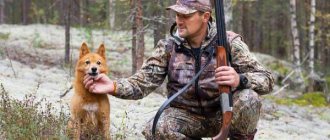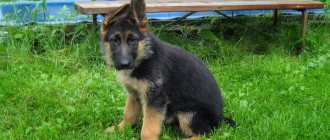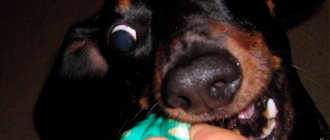Breed characteristics
| Short description | |
| Origin: | USSR, Tavria |
| Conditions of detention: | In an enclosure, on the territory of a country house, free-range |
| Purpose: | Shepherd, guard |
| Color: | White, fawn, gray, piebald, in combination with spots of the same colors |
| Wool length: | Long, at least 15 cm, rough, wavy; there is a thick undercoat; there is a characteristic bang that covers the eyes; hair is present on the body, tail, paws and head |
| Adult dog size: | Height of males from 65 cm; females from 60 cm Weight from 35 kg to 50 kg |
| Average life expectancy: | 14-15 years old |
| Walk: | Required 2 times a day, lasting at least an hour; free range preferred |
| Physical activity needs: | Significant need for high-intensity aerobic physical activity |
| Fédération Cynologique Internationale (FIC) classification: | Recognized by the FCI in 1983 Group 1. Herding and cattle dogs, except Swiss cattle dogs / Section 1. Shepherd dogs |
| Puppy price: | From 15 thousand rubles to 60 thousand rubles (individuals purchased for participation in exhibitions) |
History of the origin of the species
The first mention of the ancestors of the South Russian Shepherd Dog is usually attributed to 1797 . At the end of the 18th century, at the state level, the task was set to organize sheep breeding in the undeveloped territories of the Tauride steppes. For this purpose, fine-wooled Spanish sheep were brought to the region of modern Zaporozhye and Kherson region. Along with the flocks, special shepherd dogs – small Asturian Shepherd Dogs – were also brought to the Russian Empire.
However, representatives of this breed could not provide practical assistance to local sheep farmers. The animals were well trained to maintain order in the herd. But in the conditions of the southern, scorching heat, and in the absence of water, they were unable to cope with the main task. Being short and relatively weak in build, they were unable to protect their herds from steppe wolves.
There was a need to create a different type of powerful guard dog that would also have exceptional herding qualities. Thus, the idea of crossing imported individuals with local breeds - Tatar Shepherd Dogs and Greyhounds - appeared. The result of selection was the South Russian Shepherd Dog. Combining the strength and endurance of the first breed, and the tall stature and viciousness of individuals of the second species, the dog became an unrivaled guard.
The main distribution area of the South Russian Shepherd was Crimea. The main selection work was carried out in the large estate of Askania-Nova, located in what is now Ukraine. The documentary archive of this estate, which has survived to this day, confirms that it was here in 1856 that the largest number of individuals was recorded.
The Civil War made adjustments to the development of the breed, and the number of dogs was greatly reduced. The individuals that survived on the farms of individual shepherds and ordinary fans of this breed became the basis for restorative breeding. It was organized in the city of Dzhankoy with the support of the state. In general, the nursery staff successfully completed the task. In a short time, lines were bred that were not inferior to specimens brought from the territory of Askania-Nova and from other cities of the country.
Currently, the breed is not in high demand in the European part of Russia, but in the southern regions the number of fans is gradually increasing.
South Russian Shepherd
If you look at a photo of a South Russian Shepherd, nine out of ten people who have almost no dealings with dogs will say: it’s a mistake - shepherds are not like that.
Indeed, these breeds are associated with large, stately dogs with little fur and locator ears. This same shepherd dog looks more like an average sheep, and in a sitting position - like a Bigfoot.
Remember the film “Come to me, Mukhtar!” What a beautiful shepherd dog took part in arresting criminals! And here is a dog from nose to tail in solid white fur to his toes.
There is a similar breed in one European country - this is the “puli”, or it is also called the “Hungarian mop” for the presence of half a meter of wool. Just some kind of shock. The Central Russian Shepherd's coat almost reaches this size.
But this “robe” contains the beauty of such a shepherd, and its charm, as well as the best qualities of a guard of everything that is entrusted to it. This is evidenced by numerous reviews about the character of the South Russian Shepherd.
Note!
Nicknames for dogs for boys - easy, rare and most beautiful names for dogs in alphabetical order
Nicknames for girls' dogs - a list of beautiful, funny, unusual nicknames for large and small dog breeds
Maltipoo dog - everything about the dog from A to Z. Photos, description of the breed, character, maintenance features, prices, reviews
Distinctive features
The South Russian Shepherd has the following distinctive features:
- The skull is slightly elongated, wedge-shaped; the frontal part is relatively wide, the occipital part is clearly formed.
- The ears are triangular, medium-sized, drooping, and set high.
- The eyes are oval-shaped, small, dark in color, and set wide apart.
- The eyelids are dense and dry.
- The stop is expressed implicitly.
- The muzzle is narrowed and completely covered with hair.
- The nose is large; The lobe is black, voluminous.
- The teeth are large, white, 42 pieces.
- bite .
- The type of constitution is dry.
- The physique is strong, the muscles are powerful and dry.
- The croup is wide.
- The skin is dense, smooth; folds are completely absent.
- The chest is flat and protrudes forward.
- The neck is slightly elongated, dry, and set high.
- The loin is muscular, wide, shortened, slightly convex.
- The limbs are straight, parallel, wide, at a slight angle.
- The paws are oval, completely covered with long hair.
- The tail is long, set low, dropped down, the end has the shape of a half ring.
- Movements are free; gait - trot.
- The coat is long, at least 15 cm, coarse, wavy; there is a thick undercoat; there is a characteristic bang that covers the eyes; hair is present on the body, tail, paws and head.
- Color: white, fawn, gray, piebald, in combination with spots of the same colors.
Photo of an adult dog
Features of character and behavior
Despite the fairly balanced type of higher nervous activity, the South Russian Shepherd is not recommended for people with a soft, compliant character. Strong animals, capable of making independent decisions, these dogs must feel the unconditional leadership of the owner.
Considering the presence of an innate defensive reaction in an active form, as well as pronounced protective and watchdog qualities, a South Russian Shepherd puppy must be taught obedience from the first moments of its appearance in the house. Otherwise, by the time of puberty, the dog, especially the male, may become uncontrollable.
Some owners note that the genetic predisposition to protect their puppies in this breed sometimes transforms into a desire to protect small members of the human family . At the same time, security measures can be accompanied by aggressive actions and cross the boundaries of ordinary affection and care.
Contact of an animal that has not completed the OKD course with small children in the absence of the owner is excluded.
Advantages
“Southerners” have a lot of advantages. The main advantages of this breed over other species are the following characteristics:
- Exceptional security and protective working qualities, lightning-fast reaction, very sensitive hearing.
- High intelligence, ability to quickly and accurately follow human commands.
- Capable of performing guard duty.
- They are easy to train and smart.
- They have an innate desire for discipline.
- They are unpretentious, do not require special conditions, are able to survive for a long time without food and water, and are not influenced by the climatic environment.
- A pronounced protective instinct that must be controlled with the help of OKD and the strong, calm character of the owner. In the absence of these conditions, it turns into a strong disadvantage that poses a threat to the property and lives of others.
Flaws
The main disadvantages should be noted:
- Wayward character;
- Malice, aggressiveness, extreme distrust of strangers, can attack without warning;
- Possible manifestations of aggression towards other animals;
- with an insufficient level of control, aggressive reactions towards family members and others are likely;
- Excessive excitability;
- Not suitable for people with a soft character, impatient and unbalanced;
- Not suitable for owners who have no experience interacting with service dogs; for families with small children; elderly people;
- Cannot be kept in an apartment;
- Requires significant daily physical activity of a high intensity aerobic nature; free range is preferred;
- Regular OKD training is required; in the absence of regular training, the animal’s reaction to an unexpected, loud and suspicious sound is unpredictable and can pose a danger to those nearby;
- Careful grooming is required.
Education and training
The South Russian Shepherd is highly trainable and displays all its best qualities. Many representatives of the breed pass excellent exams in OKD, KS with elements of ZKS, IPO and agility.
There is usually no need to specifically train a dog for anger and aggression. Trainers often do not like southerners because they do not want to work according to standards. They do not hang on the sleeve, but make a series of bites in unprotected places. That is, to work with them you need a protective suit. It is expensive, but after several such dog attacks, it quickly becomes unusable.
Not everyone can be the owner of a YURO, but even fewer people will be able to properly raise a dog and become its leader. A dog with an insufficiently strong character and low intelligence will, at best, ignore an owner.
Care and maintenance
It is recommended to keep the South Russian Shepherd Dog in a large enclosure on the territory of a country house or in an unfenced area with an awning, allowing it to move freely around the site. The coarse, dense coat of dogs allows them to be in open spaces in any weather without consequences.
- Animals can easily tolerate heat, heat and stuffiness, as well as frosty days. This is one of the undoubted advantages when choosing this breed. The thick undercoat and hair present on the body, tail, paws and head make them practically invulnerable to any climatic conditions.
Keeping on a leash is not allowed. This can lead to anger and uncontrollable aggression.
- Long hair also dictates special conditions for caring for the dog.
- bathe no more than 1-2 times a year, using special shampoos with conditioner to maintain wavy hair in ideal condition.
- The presence of bangs falling over the eyes and hair on the ears reliably protect these organs from the penetration of dirt, debris and dust. It is quite enough to conduct external preventive examinations once a week.
- South Russian Shepherds have strong, white teeth , and, with proper nutrition, which includes meat and raw vegetables, do not require increased attention to them. It is recommended to examine the oral cavity 1-2 times a month. It is advisable to carry out the removal of plaque or tartar in a specialized veterinary clinic. This is especially true for individuals with a high level of excitability.
- claws , with sufficient physical activity, grind down on their own.
Nutrition
The basis of the diet of the South Russian Shepherd should be natural food - beef, sea fish, fermented milk products, eggs, cereals and raw vegetables.
A puppy up to 6 months of age is fed 5-6 times a day, with 50-60% of the daily intake being meat. The volume of the daily portion ranges from 700 g. up to 2.0 l . Over the age of 6 months, the number of feedings gradually decreases and by the first year of life it is 2 times - in the morning and in the evening.
At the same time, the volume of food and the ratio of products decreases. Morning feeding accounts for 300-350 grams . fermented milk products. Evening feeding includes 450-550 g. meat, 80-100 gr . raw vegetables (excluding onions, potatoes, cabbage, peas). If necessary, the dog’s diet can be supplemented with porridge - buckwheat and rice are mainly used for these purposes.
It is important to use vitamin complexes during natural feeding, especially during the puppy’s growth period.
It is advisable to establish a strict diet for the South Russian Shepherd and feed it “by the hour.” Meals are not allowed less than two hours before the start of active work, free walking, or going on guard duty.
Dry food is not recommended for use in the diet of the South Russian Shepherd.
If natural food is not available, it is preferable to use super premium food: ROYAL CANIN, EUKANUBA, PROPLAN (PURINA), BOSCH, HILL`S. The feed contains proteins, fats and carbohydrates in the required proportions. In this case, no additional vitamin supplements are required.
Health
"White giants" have excellent health. Strong, resilient, they practically do not get sick and often live to an advanced age for large dogs - 15-17 years. Necessary conditions for maintaining tone are:
- balanced diet, especially up to 12 months;
- daily intense physical activity, free walking.
Vaccinations
Vaccination of the South Russian Shepherd is mandatory.
After the first injection at 1.5-2 months, the puppy is quarantined. During the period from 12 to 14 days after vaccination, walking, swimming, and all contacts of the puppy with other animals are excluded. An increase in temperature and diarrhea are often noted. The vaccine is given simultaneously against plague, parainfluenza, hepatitis and parvovirus enteritis. After 21 days, revaccination is carried out. Usually, the puppy’s reaction does not cause symptoms of the first vaccine and is much easier to tolerate.
At 6 months, the puppy must receive a rabies vaccination, as well as a comprehensive vaccine. The timing of vaccinations is necessarily shifted if at this moment the dog undergoes a change of teeth. Quarantine is advisable and depends on the condition of the dog.
At 12 months, the dog is considered an adult and is vaccinated according to the 6-month schedule. Starting at this age, vaccination is carried out every year.
Diseases
Diseases characteristic of the South Russian Shepherd are few and come down to diseases typical of large breed dogs - arthritis and joint dysplasia . The disease mainly affects males over the age of 10-11 years.
Walk
Walking the dog is required on a regular basis, at least 2 times a day, for at least an hour. The ideal mode of physical activity is free range, moving around a large area. Owners of South Russian Shepherds note that the animals need to be given the opportunity to walk along a variety of routes.
These shepherds have a pronounced “possessive” instinct, and often the second time they consider the path they have traveled as a “protection zone.” The best option would be to keep the dog on a farm where they can fully realize their genetic herding predisposition.
Grooming
The coat of South Russian Shepherds requires careful care . To prevent thick hair from falling off, it must be combed regularly. Outside the molting period, the procedure is carried out 1-2 times a week with a special comb with teeth of different lengths. This type of brush is ideal for long coats and dense undercoats.
Dogs shed heavily, so during these seasonal periods, twice a year, the procedure must be carried out daily until excess hair is completely removed. For combing, use a comb with sparse teeth and blunt ends.
Grooming the animal is not recommended due to slow hair growth.
The exception is the bangs and fur on the inner surface of the animal's ears. It is permissible to use small scissors to cut (thin) the wool on these parts.
Health and major diseases
YURO has good health and if you care for him properly, then no problems should arise. But sometimes, due to poor ventilation, inflammation of the inner ear - otitis media - can occur, so it is important to clean them regularly. You should also be careful about eye hygiene.
Representatives of the breed are also often susceptible to the following ailments:
- allergy;
- eczema;
- dermatitis;
- epilepsy;
- cryptorchidism (undescended testicles into the scrotum);
- arthritis and arthrosis;
- hip dysplasia;
- lack of teeth.
Dogs' paws sweat
It turns out that dogs sweat too. But while humans sweat through the skin all over their bodies, dogs sweat through their paws. You can verify this by watching your dog on a hot summer day. A characteristic symptom will be a salty odor, reminiscent of popcorn or corn chips.
Collies were once considered a vicious breed
Collie was once considered a vicious breed of dog, mainly due to the fact that this breed is of Scottish origin, and the Scots were considered uneducated and poor people. Collies became a popular and prestigious breed in the 19th century when Queen Victoria became a fan.
Dog nose prints are as unique as human fingerprints.
Dog nose prints are unique, so they are used to identify an animal, just like fingerprints are used to identify a person. Criminologists often take advantage of this circumstance when investigating crimes involving animals and their owners.
Mating
Mating must meet the requirements for the mating process of large breeds:
- The first mating takes place at 24 months ;
- The mating period is between the 11th and 14th day after estrus (usually the third);
- Introducing dogs - in the territory of the dog;
- Time – preferably in the morning, after a long walk; It is not recommended to feed animals;
- Repeated mating - every other day.
Reviews
- Marina, 41 years old, Moscow
I love my Mars very much, but there were serious difficulties in my upbringing. At 4 months, we contacted a specialist, which could save ourselves a lot of nerve cells. Now everything is fine, he listens perfectly. We eat only about the plan, we are allergic to everything else.
- Stanislav, 34 years old, Odessa
We thought there would be problems because of the fur, but with regular grooming there are no problems, you just have to cut the bangs and ears yourself. It is enough to scratch every day and I would also recommend a balm, it is a little expensive, but after it the fur is just a fairy tale, I bought it at the veterinarian.
Share link:
Key points in training
South Russian Shepherds are highly trainable. A high level of intelligence and innate intelligence make it possible to teach a dog many commands in a short time. However, emphasis should be placed on developing obedience and unquestioning submission to the owner. Animals have a natural tendency to dominate and make decisions independently.
Read about how to properly train a dog in the article: “Training a puppy: effective methods from dog handlers, learning commands at home.”
Training should contain exercises in which the dog learns to recognize the authority of the owner in all situations. At the initial stages, it is recommended to involve a professional dog handler. In order to avoid the appearance of behavioral problems in an adult, increased attention must be paid to the training of uncastrated males.
Physical influence is unacceptable, as it can lead to an uncontrolled release of aggression.
Health Yuro
In general, health problems in South Russian Shepherds (they are sometimes also called Old Russian Shepherds) arise quite rarely - many generations of strict selection make their presence felt. Infections and colds are usually not a problem for them.
For reference! The average lifespan of dogs of this breed is 12-15 years. But if not properly cared for, it can shrink.
But genetic diseases do occur. Usually problems are caused by:
- epilepsy,
- eye diseases (entropion, cataracts),
- allergy,
- joint dysplasia,
- volvulus of the stomach.
It is very important to know and remember about these diseases - sometimes it is this knowledge that allows you to save your pet by promptly seeking help from veterinarians.
How to choose a puppy
It is better to choose a South Russian Shepherd puppy from a professional breeding kennel. This is a guarantee of acquiring a purebred individual, with a good pedigree and a stable psyche.
When choosing, you must be guided by the following points:
- The puppy must be active; sluggish movements are not typical for this breed;
- Manifestations of aggressive play are acceptable in children and should be completely excluded in adults;
- The conditions for keeping parents and offspring must meet the requirements for care - large rooms, open spaces.
South Russian Shepherd Dogs are a worthy choice for active, self-confident people with strong leadership qualities. The ability to establish unquestionable authority is one of the main conditions for a puppy to grow into a loyal, obedient friend and protector.


